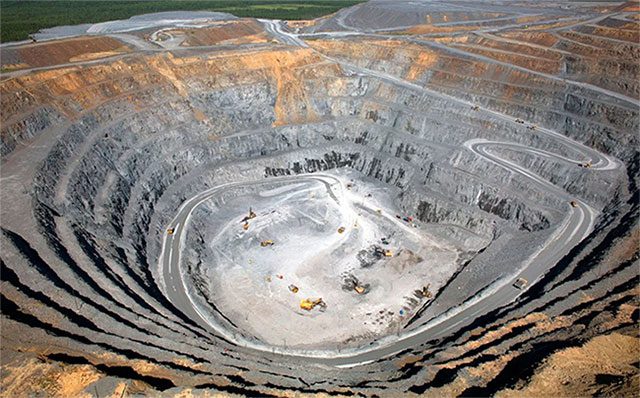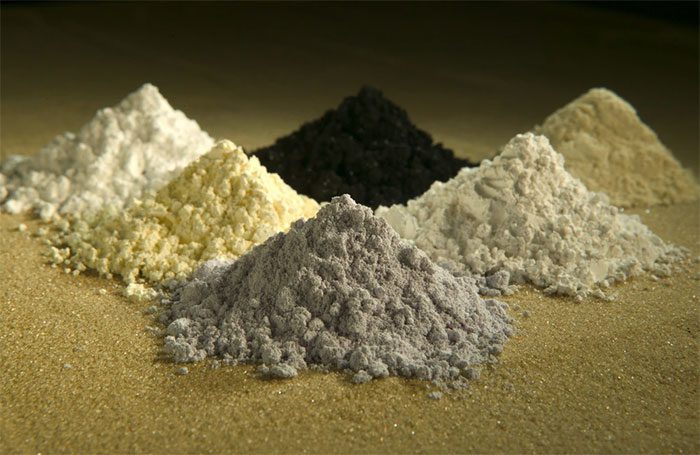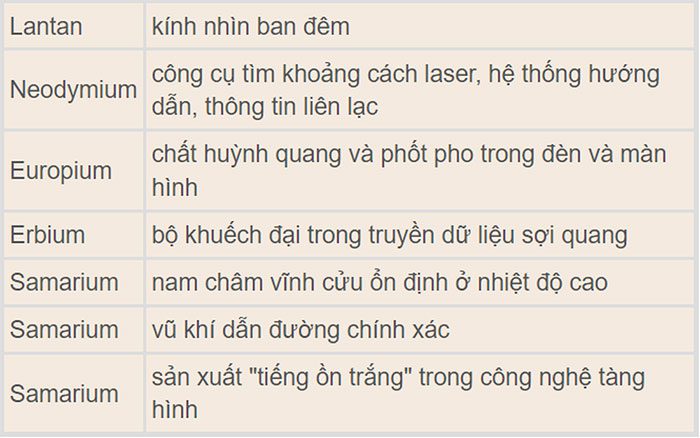This giant rare earth mineral deposit is estimated to contain up to 694 million tons, according to Anadolu Agency.
Surprising Discovery of a Massive Rare Earth Deposit in Turkey
Turkey Discovers the Second Largest Rare Earth Deposit in the World
The Turkish state news agency Anadolu Agency reports that Turkey has just discovered the second largest rare earth element deposit in the world.

Image of a rare earth mine in the world. (Source: Corsicallc)
Turkey’s Minister of Energy and Natural Resources, Fatih Donmez, revealed earlier in July 2022 that this rare earth mineral deposit is located in the Beylikova district of Eskisehir in central Anatolia (a large peninsula in Western Asia, part of Turkey).
According to Anadolu Agency, Turkey’s rare earth reserve is estimated to have a capacity of 694 million tons, ranking second only to China, which currently has the largest rare earth mine in the world with a capacity of 800 million tons.
The head of Turkey’s Ministry of Energy and Natural Resources stated that this massive rare earth deposit is located relatively shallow, making extraction easier and less costly. “Out of 17 known rare elements, we can produce 10 rare earth elements from this mine,” said Fatih Donmez.
He also announced that 250 tons of thorium would be produced at this second-largest rare earth mine in the world. Thorium is an element used as fuel in the nuclear industry. Additionally, the new reserve will allow for the processing of about 570,000 tons of ore annually.
This discovery will enable the region to produce rare earth elements, not only to meet domestic industrial demands but also for export. “We will have more opportunities to export abroad than we need domestically,” said Fatih Donmez.

The second largest rare earth mine in the world, located in Eskisehir Province, Turkey. (Photo: [email protected])
United News of India – a multilingual news agency from India – quoted the Istanbul Mineral and Metal Exporters Association (IMMIB) as stating on July 4, 2022, that this “heaven-sent” rare earth mine in Turkey is sufficient to meet global demand for 1,000 years!
Turkish media also reported that the discovery of this massive rare earth mine in Eskisehir (Northwest Turkey) will create numerous job opportunities for local residents. With 694 million tons of rare earth, Turkey is expected to earn billions of USD for its economy.
Metin Cekic, a member of IMMIB, excitedly stated: “The extraction of the second largest rare earth mine in the world will allow Turkey to join the world’s forefront in the production of rare earth materials.”
What Are Rare Earth Elements? Why Are They Important?
1. What Are Rare Earth Elements?
According to the United States Geological Survey, rare earth elements (REEs) are a group of 17 metallic elements. They include 15 elements in the lanthanide series of the periodic table, along with scandium and yttrium.
[The 15 lanthanide metals include: Lanthanum, cerium, praseodymium, neodymium, promethium, samarium, europium, gadolinium, terbium, dysprosium, holmium, erbium, thulium, ytterbium, and lutetium].
According to Geoscience News and Information, rare earth elements are all metals, and this group is often referred to as “rare earth metals.” These metals share many similar properties, which often leads them to be found together in geological deposits. They are also called “rare earth oxides” because many of them are commonly sold in oxide compound form.
2. Why Are Rare Earth Materials Important?
The United States Geological Survey states that rare earth materials are an essential part of many high-tech devices. Rare earth metals and the alloys containing them are used in fields such as aerospace, defense, space industry, and biomedicine…

Some rare earth oxides. Clockwise from the top center (black) are: Praseodymium, cerium, lanthanum, neodymium, samarium, and gadolinium. (Photo: Peggy Greb, USDA image gallery).
In the report “Going Critical” by the United States Geological Survey:
“Rare earth elements (REE) are essential components of more than 200 products in various applications, especially high-tech consumer products such as mobile phones, computer hard drives, electric vehicles, hybrid cars, flat screens, and televisions.”
Important defense applications include electronic displays, guidance systems, lasers, and radar and sonar systems.
Although the amount of REE used in a product may not represent a significant part of that product by weight, value, or volume, REE are crucial for the functionality of a device. For instance, magnets made from REE often constitute only a small fraction of the total weight, but without them, the spindle motors and voice coils of desktop and laptop computers would not operate.
In 1993, 38% of the world’s REE production was in China, 33% in the USA, 12% in Australia, and 5% in Malaysia, with another 5% in India. Other countries, including Brazil, Canada, South Africa, Sri Lanka, and Thailand, made up the remainder.
However, by 2008, China accounted for over 90% of global REE production, and by 2011, China represented 97% of global production.”
The Role of Rare Earth Materials in Specific Fields
In Technology
Geoscience News and Information notes that over the past 20 years, there has been a surge in demand for many items requiring rare earth metals. Twenty years ago, few people owned mobile phones; today, more than 5 billion people own mobile devices.
The use of rare earth elements in computers has also rapidly expanded alongside mobile phones. Many rechargeable batteries are made with rare earth compounds. The demand for batteries is driven by the need for handheld electronic devices (besides mobile phones) such as e-readers, laptops, and cameras.
In Electric Vehicles
Several kilograms of rare earth compounds are found in the batteries powering every electric and hybrid vehicle. As concerns about energy independence, climate change, and other issues drive the sales of electric and hybrid vehicles, the demand for rare earth-based batteries is expected to grow even more rapidly on a global scale.
Additionally, rare earths are used as catalysts, phosphors, and polishing compounds. They are utilized to control air pollution, in lighting displays on electronic devices, and in polishing optical-quality glass. All these products are expected to see high demand.
Other substances can be substituted for rare earth elements in their most critical applications; however, these alternatives often prove less effective and more costly.
In Defense
Rare earth elements play an essential role in defense. The military uses night vision goggles, precision-guided munitions, communication devices, GPS equipment, batteries, and other defense electronics—all of which require the presence of rare earth materials.
Rare earth metals are key components in producing very hard alloys used in armored vehicles. While alternatives can be used for rare earth materials in some defense applications, those substitutes often prove less effective and diminish military advantages.
Some other specific uses of rare earth elements are summarized in this table:

Some uses of rare earths. (Source: Geoscience News and Information)
Are Rare Earth Elements Really “Rare”?
Rare earth elements are not as “rare” as their name suggests. In fact, rare earth elements are relatively abundant in the Earth’s crust, but their economically extractable concentrations are less common than most other ore types.
Thulium and lutetium are the two least abundant rare earth elements, yet they are nearly 200 times more abundant in the Earth’s crust than gold. However, these two rare earth elements are very difficult to mine, as finding them in economically viable concentrations is quite challenging.
The most abundant rare earth elements include: cerium, yttrium, lanthanum, and neodymium. Their average abundance in the Earth’s crust is similar to that of commonly used industrial metals such as chromium, nickel, zinc, molybdenum, tin, tungsten, and lead.
However, the issue that makes them ‘rare’ is that they are seldom found in concentrations that can be economically extracted (cost-effective).
Globally, China is the largest producer of rare earth materials [as of 2011, when it controlled about 97% of the world’s rare earth production]. Additionally, China is also the largest consumer, using rare earths primarily for manufacturing electronic products for both domestic markets and exports, according to Geoscience News and Information.
Meanwhile, Japan and the United States are the second and third largest consumers of rare earth materials in the world.
Other countries have also begun producing rare earth elements over the past decade.
Australia began producing rare earth oxide in 2011. In 2012 and 2013, they supplied about 2% to 3% of the world’s output.

The Mountain Pass rare earth mine, aerial view. This large open-pit mine is located in the Clark Mountains of California, USA. Operated by Molycorp, it is the only rare earth oxide (REO) mine in the Western Hemisphere. (Photo: MASSIMO BREGA / SCIENCE PHOTO LIBRARY)
In 2012, the Mountain Pass mine in California resumed operations, enabling the U.S. to produce approximately 4% of the world’s rare earth materials by 2013. Production of rare earth materials in Brazil, Malaysia, Russia, and Thailand continues to either stabilize or increase.
With Turkey discovering the second-largest rare earth mine in the world, many countries are hopeful this will provide a substantial supply of rare earths, as the world requires these materials for various critical industries.





















































